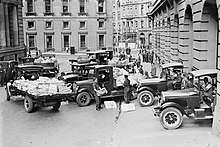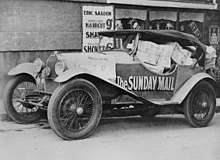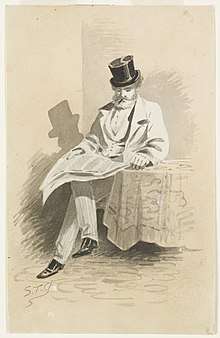Newspapers in Australia
There are two national and 10 state/territory daily newspapers, 35 regional dailies and 470 other regional and suburban newspapers in Australia. The two national daily newspapers are The Australian and The Australian Financial Review. Other notable newspapers are The Canberra Times, The Sydney Morning Herald, The Daily Telegraph, The Age, and The Herald Sun (Melbourne). All major metropolitan newspapers are owned either by News Limited, a subsidiary of News Corporation, or Fairfax Media, except The West Australian and The Sunday Times

History

_2.jpg)


19th century
Australia's first newspaper was the Sydney Gazette and New South Wales Advertiser, that began in 1803. In 1810, the second newspaper in Australia, the Derwent Star and Van Diemen's Land Intelligencer was founded in Van Diemen's Land (Tasmania), but it was short-lived and ceased publication the same year.[1][2] Victoria's first paper was the Melbourne Advertiser which began in 1838. By the mid-1850s, there were 11 papers in Tasmania. The Tasmanian and Port Dalrymple Advertiser founded in Launceston in 1825 was the first provincial newspaper in Australia.[3]
Early newspapers tended to consist of four pages and generally appeared one or two days a week. They were hindered by occasional shortages of suitable paper, ink, compositors and printers. Publication sometimes had to be suspended due to such shortages.
Australia's longest-running newspaper, the Sydney Morning Herald, was first published as the Sydney Herald in 1831. The Herald's rival, The Daily Telegraph, was first published in July 1879. Weekly newspapers were an important feature of the Australian newspaper scene in the nineteenth century. Illustrated newspapers became increasingly important. They initially featured woodcut engravings and toward the end on the nineteenth century black and white photographs began to appear.
Australia's first foreign-language newspaper, Die Deutsche Post für die australischen Kolonien was published in Adelaide from 1848–1850.[1]
Australia's first national daily newspaper, Daily Commercial News (now Lloyd's List Australia) was first published in April 1891.[4] Only during the second part of the twentieth century did other national newspapers start to be published.[3]
Newspapers played an important role in Australia in the nineteenth century. According to historian and former newspaper man Thomas McCombie in his, History of the Colony of Victoria (1858),
the newspaper press constitutes nearly the only literature published in the Australian colonies. It monopolises the greater part of the thought. The newspaper occupy the space of all literature, and stop the channels of information from all other sources; by far the largest class derive no information from any other quarter ...[5]
These sentiments were echoed by Richard Twopeny in, Town Life in Australia (1883),
This is essentially the land of newspapers. Nearly everyone can read, and nearly everybody has the leisure to do so ... The proportion of the population who can afford to purchase and subscribe to newspapers is ten times as large as in England; hence the number of sheets issued is comparatively much greater.[6]
This national obsession with newspapers continued into the 20th century so that historian Ken Inglis could note in 1962 that,
Australians are more intensely addicted to daily newspapers than almost all other people in the world ... We buy more than 40 papers a day per 100 of population. Nearly 90 per cent of us usually read, or look at, a morning paper, and 70 per cent an evening paper.[7]
20th century
There were 26 metropolitan dailies in 1924, but this had fallen to just 14 by the 1960s due to closures and amalgamations.[8] During the same period, the number of separate proprietors had gone from 21 to seven.
During the 1980s and 1990s colour printing and cold offset printing took place in the production of newspapers. Many newspapers became available in electronic form either on CD-ROM or via the World Wide Web.[3]
21st century
The disruption of traditional print media by digital media that began late in the 20th century continued into the 21st century. In response, newspapers in Australia closed, amalgamated and/or laid off staff. All major newspapers and most minor newspapers in Australia now produce a digital version of their publication. Some periodicals produce a digital version only. Further major changes to legacy media in Australia seem inevitable.
See also
References
- Womersley, Judith. AussieData: From Prehistory to the Present. Wakefield Press. ISBN 978-1-86254-545-8.
- "Press timeline 1802 - 1850". National Library of Australia. 25 January 2012. Retrieved 14 July 2020.
- Isaacs, V.; Kirkpatrick, R. (2003). Two Hundred Years of Sydney Newspapers: A Short History (PDF). New South Wales: Rural Press Ltd. Archived from the original (pdf) on 11 September 2003. Retrieved 9 November 2008.
- "Daily commercial news and shipping list", Trove, National Library of Australia.
- McCombie, Thomas (1858), A History of the Colony of Victoria from its Settlement to the Death of Sir Charles Hotham, Melbourne, Sands & Kenny, p.323
- Twopeny, R.E.N. (1883) Town Life in Australia, London, Eliot Stock, p.221
- K.S. Inglis, “The daily papers,” p.145, in, Coleman, Peter (ed.) (1962), Australian civilization, Melbourne, F.W. Cheshire
- Inglis, p.147
Further reading
- Collins, Ross F.; Palmegiano, E. M. Rise of Western Journalism, 1815–1914: Essays on the Press in Australia, Canada, France, Germany, Great Britain & the United States (2008)
- Cryle, Denis. "The Empire Press Union and Antipodean communications: Australian-New Zealand involvement 1909–1950." Media History (2002) 8#1 pp: 49–62.
- Cryle, Denis. "The press and public service broadcasting: Neville Petersen's news not views and the case for Australian exceptionalism." (2014) Media International Australia, Incorporating Culture & Policy Issue 151 (May 2014): 56+.
- Cryle, Denis. "The ebb and flow of the Tasman mediasphere: a century of Australian and New Zealand print media development, 1840–1940." (2005). online
- Cryle, D. Disreputable Profession: Journalists and Journalism in Colonial Australia (Central Queensland University Press: Rockhampton, Queensland, (1997)
- Dunstan, David, “Twists and turns: The origins and transformations of Melbourne’s metropolitan press in the nineteenth century,” Victorian Historical Journal, 89 (1) June 2018, 5-26
- Griffen-Foley, Bridget. "'Four More Points than Moses': Dr. HV Evatt, the Press and the 1944 Referendum." Labour History (1995): 63–79. in JSTOR
- Isaacs, V.; Kirkpatrick, R. (2003). Two Hundred Years of Sydney Newspapers: A Short History (PDF). New South Wales: Rural Press Ltd. Archived from the original (PDF) on 11 September 2003. Retrieved 9 November 2008.
- Kirkpatrick, Rod. "The provincial press and politics: NSW, 1841–1930." Australian Studies in Journalism 8 (1999): 96-117.
- Manion, James. "History of newspapers in North Queensland." Journal of the Royal Historical Society of Queensland 11.4 (1981): 139–151. online
- Pearce, S. Shameless Scribblers: Australian Women's Journalism 1880–1995 (Central Queensland University Press: Rockhampton, Queensland, 1998)
- Read, Donald. "Reuters: News agency of the British empire." Contemporary British History 8.2 (1994): 195–212.
- Richardson, Nick. "From 'rags' to 'riches': The evolution of the Australian suburban newspaper." Media International Australia, Incorporating Culture & Policy 150 (2014): 83+.
- Van Heekeren, Margaret. "'Office boys' or intellectuals?: Sydney Morning Herald editors from 1903–1937." Australian Journalism Review 32#2 (2010): 75+.
- Vine, Josie. "'If I Must Die, Let Me Die Drinking at an Inn': The Tradition of Alcohol Consumption in Australian Journalism" Australia Journalism Monographs (2010) v 12 (Griffith Centre for Cultural Research, Griffith University)
- Walker, R. B. (1976), The newspaper press in New South Wales, 1803–1920, Sydney University Press. ISBN 0424000237
- Walker, Robin Berwick. Yesterday's news: history of the newspaper press in New South Wales from 1920 to 1945 (Intl Specialized Book Service Inc, 1980)